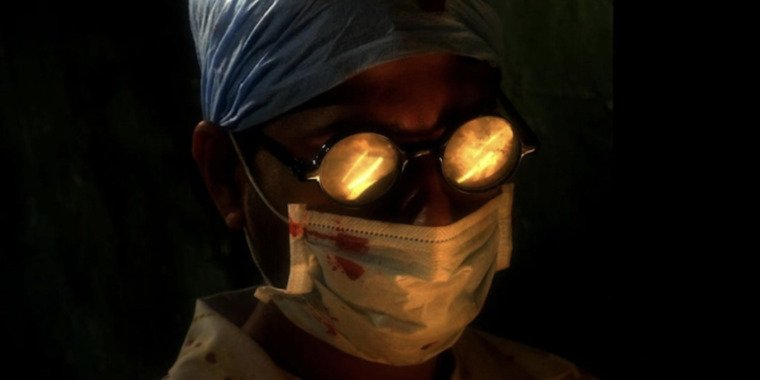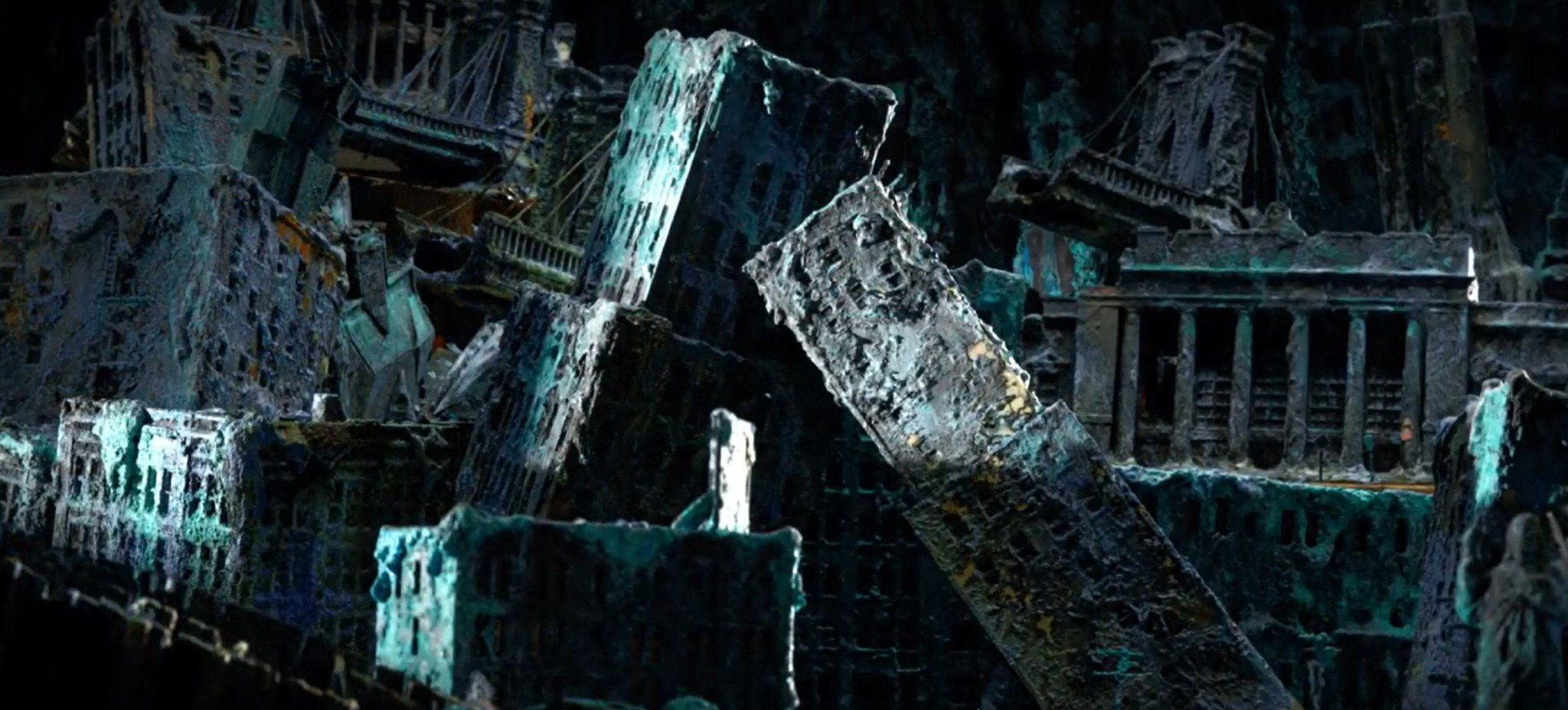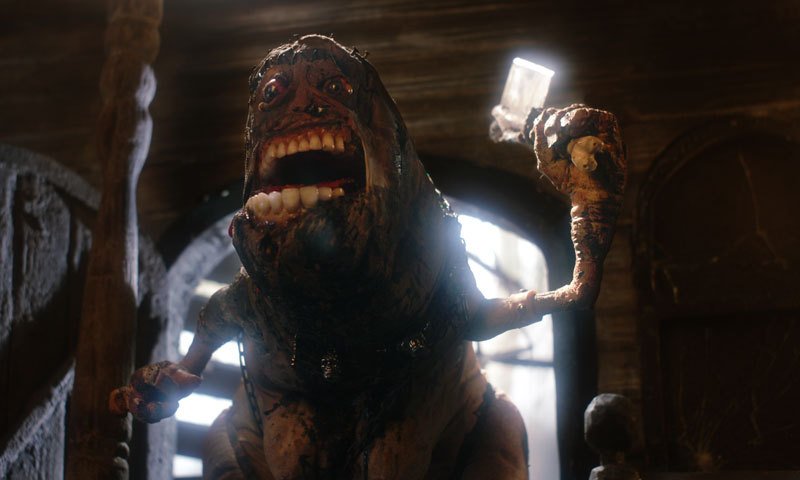The production of ‘Mad God’ began over thirty years ago. Phil Tippett shelved it before resuming work in the early-2010s, finishing it eventually in 2021 through Kickstarter donations. It’s a film that has therefore taken decades to make yet it takes about five minutes for it to justify such a long production.
Brimming with elaborate stop-motion sequences and positively gnarly imagery, ‘Mad God’ is a nightmare brought to life. The creatures in it can each serve as the central antagonist of a horror franchise and it relentlessly assaults us with its copious horrors in what becomes a surrealistic fever dream. A visionary work, ‘Mad God’ doesn’t quite seem concerned with the plot and works wonderfully as a sensory experience. Still, through a clear influence of religion and politics, it has the quality of a puzzle that can prove most rewarding when decoded.
Mad God Plot Summary & Movie Synopsis:
A wispy, ghostlike creature appears on the top of a tower with seven levels. Thunder strikes it and the world is seemingly consumed by dark matter descending on it. This is followed by a scroll that concisely expresses what is written down in Leviticus 26-27. Rather, the section of it where God tells Moses about the curses that will be brought down on the Israelites if they’re disobedient to his laws.
An individual, armored and with a gas mask on, resembling soldiers in the trenches of the First World War, descends in a diving bell from the sky into a heavily guarded fortress. As the guards become aware of him, they try to shoot down the diving bell but they fail and it passes on to the netherworld. Here, the soldier (called The Assassin), passes through various levels, each housing unique entities. One is a cross-section of a terrain full of fossils while another is a lifeless hall full of idols. He finally lands on the sixth level and continues his journey forward on foot. He passes through a labyrinth of infernal horrors as he slowly makes his way down from one level to the next. He has a map in his possession that keeps disintegrating, possibly ridding itself of the parts that have already been covered by its user. Finally, on the ninth level, he finds himself in a room full of briefcases. He too has one in his possession and we see that there’s a time-bomb inside it. As he times it to explode, an unknown force snatches him away.
The Assassin is placed on an operating table and stripped for the entertainment of unknown spectators. It turns out that innumerable others have faced his fate and that possibly, they were all on the same mission in which they failed. He is then operated on by a sadistic doctor who rips his chest apart, pulling out jewels and books, eventually finding the object of his search – a hairy, inhuman infant. The doctor then drills into the Assassin’s head and starts looking into his memories.
In a frigid world, numerous people in the Assassin’s attire are engaged in physical labor in what resembles a grotesque version of a Soviet labor camp. The Last Man, with comically long fingernails, keeps a watch over them. He is then handed a map by three witches who have just stitched it together. He looks it over, validates its accuracy, and then proceeds into a hall where again, numerous men in the Assassin’s attire are standing in attention. He walks to a diving bell that is to be lowered and hands the map over to the Assassin inside. The Assassin begins his journey as the Last Man keeps a watch over him through an elaborate surveillance system. He lands in a dystopian landscape, then finds himself in a warzone before beginning his descent into what seems like a bottomless staircase. At this point, it cuts back to the doctor operating on the Assassin as what followed the descent was the first act of the film, before the Assassin’s capture.
The nurse takes the wailing infant and hands it over to a ghostlike creature who is dressed like an early modern plague doctor. The creature carries the baby through another series of terrifying landscapes before arriving in the laboratory of an alchemist. The alchemist is also a sadistic master who tortures his servants and kills his pets according to his own whims. The ghostlike creature brings the infant to the alchemist.
Mad God Movie Themes Explained:
Numbers, literature, and mythology:
There’s a substantial heritage of art that Tippett is borrowing from in creating ‘Mad God’. While these elements are mostly cosmetic, used more to make Tippett’s vision cohere as opposed to being a reinterpretation or reworking of them, a quick look at them can be helpful in dissecting the pieces of this densely loaded work of art.
Numbers are of key importance to this world. The opening shot shows what seems like a completed iteration of the Tower of Babel. If it is so, the edifice having seven levels is fitting as they represent the seven cardinal sins prevalent in Christian theology. In the ‘Inferno’ section of Dante Alighieri’s ‘The Divine Comedy’, Dante takes a journey through Hell (accompanied by Virgil), discovering that Hell consists of nine concentric circles in the underworld, each circle representing the intensification of sins and their subsequent punishment as the circles move inwards.
The Assassin traverses eight levels of the netherworld before getting captured in the ninth level, hearkening back to this archetypal representation of Hell as was established by Dante. The map that the Assassin uses in his journey was created by three witches, which is possibly a reference to the three witches in ‘Macbeth’ who prophesied Macbeth’s ascent to the throne of Scotland, thereby sealing his violent and eventually tragic fate. In a similar fashion, the map, which is to be the guide of the Assassin and all those who are made to venture into the netherworld in the film, is what leads them through the monstrous worlds before causing their gruesome death.
The key visual influences for Tippett from the fine arts are evidently the works of Hieronymus Bosch and Zdzisław Beksiński. Bosch was a Dutch painter of the Early Netherlandish period who is today renowned for three triptych artworks that he made during his lifetime. Two of these works, ‘The Garden of Earthly Delights’ and ‘The Last Judgement’ are especially prominent in the film. Their loaded imagery brimming with surrealistic creatures and a nightmarish representation of the celestial and the netherworld has a lot of parallels with the film’s portrayal of macabre creatures that populate its worlds.
These triptychs also portray the mechanisms that are used for torture and punishment and the activities carried on by the denizens of Hell. Beksiński was a Polish artist and a leading figure of contemporary Polish art in the latter part of the 20th century. Against Bosch’s maximalist horrors, Beksiński’s works are minimalistic in their chilling portrayals of dystopian landscapes, bringing to life the worst anxieties of the Cold War. These terrains, gargantuan and mired in death and decay, birthing the most infernal mutants, evoke a similar mood to what Tippett does in ‘Mad God’.
From the film, influences range from Fellini or Wojciech Has’s packed presentation of oneiric worlds to Jorodowsky’s brand of surrealism, ranging from scatology to alchemy. Lynch’s ‘Eraserhead’ is also an evident influence given that film’s bleak industrial world and especially because of the mutant baby that is extracted from the Assassin. There’s also references to Lang’s works, especially the harrowing imagery of industry like that in ‘Metropolis’ and the world of death in ‘Destiny’. In terms of style of animation, it’s the surrealistic works of Švankmajer and the Quay Brothers, especially their own iteration of a decayed mechanical underworld in ‘Street of Crocodiles’.
A World Abandoned by God:
‘Mad God’ takes place in worlds so filthy and steeped in the wreckage that they seem excessive even in terms of depicting a post-apocalyptic world. Here, it is important to note how the film begins. The tower in the beginning, clearly a completed structure, has to be the tower of Babel from the Book of Genesis. It even looks like the Tower of Babel in Gustave Dore’s woodcut ‘The Confusion of Tongues’. In the story about this Tower, the people of Babylon start constructing a structure under Nimrod’s orders, one that would lead them to the heavens. God views this as an act of immense pride and interrupts their work on it, cursing the workers to start speaking different languages and spreading them around the world. In the world of ‘Mad God’, the film begins with what seems like people celebrating the completion of the tower’s construction.
Following this, we are presented with a summary of God’s warnings to the Israelites in case of their disobedience in the Book of Leviticus. God threatens the people with hostility, forceful cannibalism, famine, plague, and a plethora of horrors should they not uphold the ten commandments. The fact that the people in this world have completed the tower of Babel and hence can reach God, symbolically becoming His equal, is an immensely hubristic act while also breaking the commandment forbidding them from worshipping any other God.
Hence, what we see in ‘Mad God’ is a world abandoned by God, replete with the horrors promised by him. So it might not even be that it is a ‘post-apocalyptic’ world but that it really is a world that has been lacking any creation of God, to begin with, a world that has grown out of Hell itself. This seeps into the film’s larger distrust in God’s powers, which allows the existence of the grotesque creatures and Hell itself. The Last Man, who is seen as God, doesn’t occupy some ethereal realm but watches over what appears to be a bleak and wintry labor camp.
Hell as an industrial dystopia:
When the Assassin passes through the eighth level of the netherworld, we see at work a grisly factory. Here, the workers who are straw figures and all look the same, quietly labor in what seems like a ceaseless cycle. The workers are all mute and they even put themselves into the grinder in which giant worms are crushed. Occupational hazards are so common that there’s a train with coaches dedicated to collecting the workers who have been killed in some gruesome fashion during the performance of their duties. Deformed monstrosities discipline the workers with whips and the sound of a baby on PA speakers is heard, apparently commanding them.
While the film abounds in religious allegories, this is an instance of its critique of the post-Industrial Revolution world, in a fashion that seems like something a Victorian English writer would conjure up. Most importantly, this is when we’re shown for the first time, the connection between the levels of the netherworld – gigantic humanoids on the seventh level, rendered incontinent by being perpetually electrocuted have their excrement used up to power the machines on the eighth level.
A baby’s incoherent babble replacing actual commands mocks the manner in which the working class is ordered around by the ruling class yet the fact that they still quietly listen to shows how deeply ingrained their shackles are. The guards who are atrociously deformed creatures look like caricatures of entities exposed to high levels of radiation. This ties into one of the film’s persistent concerns – that of a nuclear holocaust.
The level itself has structures resembling nuclear power plants; nuclear explosions can be seen in the distance when the Assassin is seen traversing a war zone in his memories and the alchemist amusingly watches nuclear explosions through his telescope towards the end. This level might just be what exists beyond Moloch’s mechanical face, to which the workers are fed, that Freder sees in his nightmare vision in ‘Metropolis’.
Mad God Movie Ending Explained:
In the alchemist’s laboratory, the ghostlike creature crushes the infant into a syrupy substance. The alchemist takes this syrup and through an elaborate procedure, solidifies it into a block, before crushing it into a luminous powder. The ghostlike creature takes this powder and pours this out into the world outside the laboratory. This leads to a big bang-like explosion from which the universe is created. Spaceships roam around the galaxy and life starts blooming on earth. Soon, the creatures evolve and the modern world is formed, before getting decimated entirely by a bomb akin to what the Assassin was carrying. The ticking of clocks in a room then shows the passage of time in the world and the netherworld following the apocalypse before arriving at the Assassin’s bomb. A cuckoo clock shows up on screen as the bomb is about to explode and the screen fades to black. The final frame shows the Last Man looking down at the world below, in anticipation for the bomb to explode.
By showing the universe coming into existence from a dust-like substance, the film again harkens back to its concerns with Christian theology. Tippett depicts the Jupiter monolith from ‘2001: A Space Odyssey’ as both, creating life on Earth and also as a conceit to show the rapid passage of time, much like the renowned match cut from 2001 that showed the passage of millions of years between cuts after the monolith’s appearance.
The creation of the world and its destruction, followed by an anticipation of the destruction of its remains (which is the world through which the Assassin passes) hints at the fact that what the film depicted was a world that had reached the bottom of its degradation. Hence, the sending of the Assassin becomes necessary for the world to get destroyed and then be reborn again. The spreading of the dust then becomes a montage showing how the world arrived at this stage while speeding up time for the bomb to explode.
If we view the Last Man as God, orchestrating what happens to the world, the ghostlike creature becomes his emissary. Its appearance atop the tower brought darkness down on the world and it eventually escorted the baby that provided the matter to speed up the destruction of the rotten world. It even wears the attire of a plague doctor, making it seem like it is its mission to rid the world of the pestilence that has infested it down to its very bones.
Interestingly, there’s a hint at the existence of multiple worlds when multiple monoliths are ejected in the wake of the Earth’s annihilation. The Assassin-like people standing in formation around the launchpad of the diving bell can either be those supposed to go on similar missions to other worlds awaiting destruction or because they’re lined up to play their part in the cyclical birth, destruction, and rebirth of our world.
Mad God is currently available to stream on Shudder and hoopla
Also, Read: Mad God [2021]: ‘Locarno’ Review – A Bizarre, Surrealist Cinematic Experience
Mad God (2021) Movie Links – IMDb
Voice Cast – Alex Cox, Niketa Roman, Satish Ratakonda





![A Perfect Day for Caribou [2022]: ‘Locarno’ Review – An Oddly Touching Drama with an Interesting Mix of Dry Humor, Absurdism, and Melancholy](https://79468c92.delivery.rocketcdn.me/wp-content/uploads/2022/08/A-Perfect-Day-for-Caribou-2022-768x576.jpg)

![The Cathedral [2022]: ‘Sundance’ Review – An experimental and meditative family portrait that looks at the ever-changing American landscape](https://79468c92.delivery.rocketcdn.me/wp-content/uploads/2022/01/The-Cathedral-Sundance-3-768x432.jpg)
![Women is Losers [2021]: ‘SXSW’ Review – 60s set feminist fable suffers from a heavy-handed approach](https://79468c92.delivery.rocketcdn.me/wp-content/uploads/2021/03/Women-is-Losers-1-highonfilms-768x433.jpg)
![Wrath Of Man [2021] Review : Guy Ritchie’s Stab At The Crime Epic](https://79468c92.delivery.rocketcdn.me/wp-content/uploads/2021/06/wrath-of-man-768x512.jpg)
